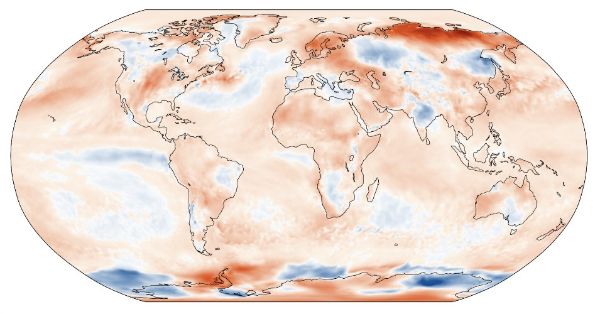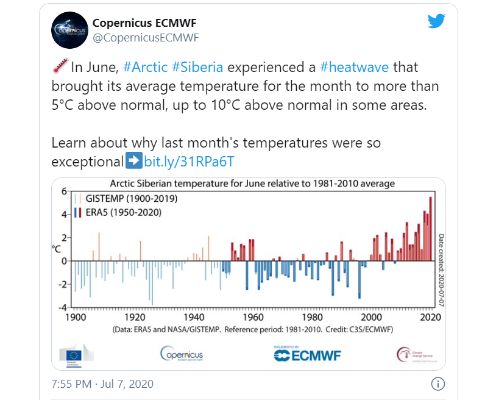As Arctic Burns, New Data Shows June 2020 Capped Off Year Tied For Hottest On Record
"So I ask again: where are the breaking news?" tweeted teen climate activist Greta Thunberg. "Where are the front pages? Where are the emergency meetings? Where are the adults?"
by Jessica Corbett, staff writer

The unprecedented heat and fires that ravaged Siberia last month came at the tail end of a 12-month period that European researchers revealed Tuesday effectively tied with the hottest year on record based on global surface temperatures, bolstering calls from activists for international bodies and governments across the globe to take immediate action to tackle the climate crisis.
As Carbon Brief noted on Twitter, the 12-month period ending in June aligned with a record from August 2015 to September 2016. The findings come from the Copernicus Climate Change Service (C3S), which is implemented by the European Center for Medium-Range Weather Forecasts (ECMWF) on behalf of the European Commission.
Swedish 17-year-old climate activist Greta Thunberg, founder of the global youth-led Fridays for Future movement, responded to Carbon Brief's tweets about the new C3S report with a series of questions reiterating her challenge to reporters, governments, and other "adults" to take the planetary emergency seriously:
The European researchers found that during June 2020 alone, global temperatures were 0.53°C warmer than the average for June 1981–2010. Last month was also less than 0.01°C cooler than the warmest June on record in 2019 and 0.1°C warmer than the third warmest June in 2016.
In a press statement Tuesday, C3S explained that in terms of data from June 2020,
the most striking regional feature was exceptional warmth over Arctic Siberia, where average temperatures reached as high as 10°C above normal for June. The temperature averaged over all land in Arctic Siberia combined was more than five degrees above normal, and more than a degree higher than in 2018 and 2019, the two previous warmest Junes.
"Finding what caused these record temperatures is not a straightforward endeavor as there are many contributing factors interacting with each other," said C3S director Carlo Buontempo. "Siberia and the Arctic Circle in general have large fluctuations from year to year and have experienced other relatively warm Junes before."
"What is worrisome is that the Arctic is warming faster than the rest of the world," he continued. "Western Siberia experiencing warmer-than-average temperatures so long during the winter and spring is unusual, and the exceptionally high temperatures in Arctic Siberia that have occurred now in June 2020 are equally a cause for concern."
As Common Dreams reported June 27, experts linked the temperatures and fires in Siberia last month to the climate crisis. "Had the climate not changed due to man-made greenhouse gases, the heat we've seen in parts of Siberia would have been a 100,000-year event," said Weather Channel meteorologist Carl Parker.
Copernicus Atmosphere Monitoring Service (CAMS) senior scientist and ECMWF wildfire expert Mark Parrington said Tuesday that "what is remarkable with these fires in Siberia is the striking similarity with what we saw over the same period of last year in terms of both the area affected and the scale of the fires."
"Last year was already by far an unusual, and record, summer for fires in the Arctic Circle in our Global Fire Assimilation System dataset, which goes back to 2003," said Parrington. "This year has evolved in a very similar way and if it continues to progress like last year, we could see intense activity for the next few weeks."
"Higher temperatures and drier surface conditions are providing ideal conditions for these fires to burn and to persist for so long over such a large area," he added. "We have seen very similar patterns in the fire activity and soil moisture anomalies across the region in our fire monitoring activities over the last few years."

During the July 2019–June 2020 period, global temperatures were "well above the 1981–2010 average over a large part of Siberia and the Arctic Ocean to the north, to the north of Alaska, and over parts of West Antarctica" as well as "above average over virtually all of Europe," according to C3S.
"Globally, the 12-month period from July 2019 to June 2020 was 0.65°C warmer than the 1981-2010 average," the new C3S report says. "The value for this period is very close to that of the 12-month periods ending in May 2020 and September 2016, the two warmest such periods in this record."


 UN News: Guterres Alarmed By Israeli Plans To Expand Gaza Ground Offensive
UN News: Guterres Alarmed By Israeli Plans To Expand Gaza Ground Offensive Caleb Fotheringham, RNZ Pacific: Poverty Persists Across PNG And Pacific Despite Economic Growth - World Bank
Caleb Fotheringham, RNZ Pacific: Poverty Persists Across PNG And Pacific Despite Economic Growth - World Bank 350.org: 350.org Pacific Reacts To Albanese Win In Australia Federal Elections
350.org: 350.org Pacific Reacts To Albanese Win In Australia Federal Elections Carbon Market Watch: Cookstove Carbon Credits: Recipe For Cooking The Climate Books
Carbon Market Watch: Cookstove Carbon Credits: Recipe For Cooking The Climate Books Reporters Without Borders: RSF Releases 2025 World Press Freedom Index
Reporters Without Borders: RSF Releases 2025 World Press Freedom Index PACER Plus: PACER Plus Joint Committee To Convene In Honiara For Critical Talks On Regional Economic Cooperation
PACER Plus: PACER Plus Joint Committee To Convene In Honiara For Critical Talks On Regional Economic Cooperation